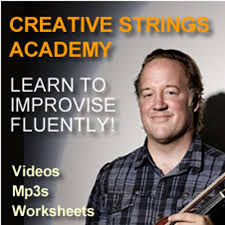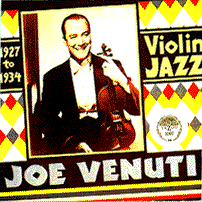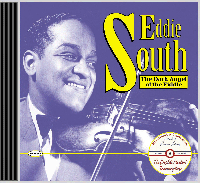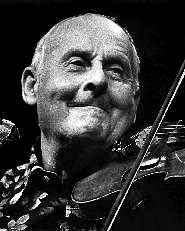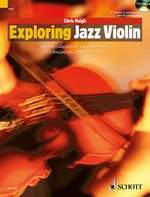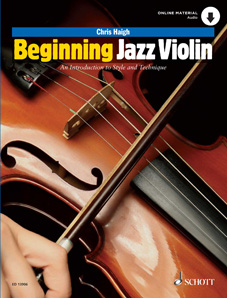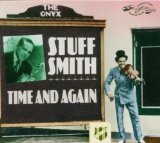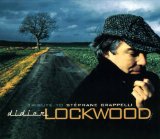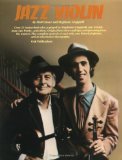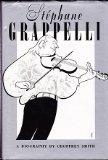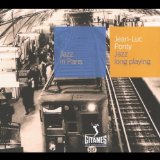
Try this intensive online "Creative
MENU TO FIDDLE STYLES:
VISIT THE FIDDLE CHANNEL
FOR FREE JAZZ VIOLIN LESSONS,TUTORIALS, AND WORKSHOPS!
Jazz Violin
Whilst no-one questions the position of the fiddler in any kind of folk band, the jazz violinist constantly has to justify himself in the face of sceptics who believe that we should stick to either Bach or barndances. The violin is still not widely seen as being a natural instrument for swing, despite a history going back to the early days of Jazz.
First among the pioneers of jazz violin was Joe Venuti (1903-78), an eccentric and highly accomplished swing player who enjoyed a long and fruitful partnership with guitarist Eddie Lang, and had a great reputation as a practical joker. His style included many double stops, and he invented a bizarre method of playing by loosening the hairs of his bow and wrapping them round all four strings, with the bow stick underneath the violin; he could then scrape away with otherwise impossible quadruple stops! (MORE ON JOE VENUTI)
Eddie South (1904-62) learned classical violin before turning to jazz. Though American born he studied in Budapest and developed a warm, passionate gypsy feel to his playing which earned him the name "the Dark Angel of the violin". Much of his playing and recording career was spent in Paris.
Stuff Smith, another black American fiddler, had a much more raucous and bluesey approach, and continued the double stopping technique of Venuti.. His playing was characterised by the use of short, punchy horn lines, quite different from the long, flowing phrases of fiddlers like Grappelli. He used the bow "like a horn player uses breath control.", staying mostly at the tip to achieve control and attack. He worked with many of the jazz greats including Oscar Peterson, Jelly Roll Morton and Dizzy Gillespie. (MORE ON STUFF SMITH)
Other American jazz fiddlers included Paul Nero (1917-58), famous for his hugely popular The Hot Canary, Hal Otis (1922-74), who among others worked with the Stan Kenton Orchestra, and John Frigo (b.1916), whose playing encompasses Jazz, rock, country and Latin.
Not all the great jazz violinists were American. Svend Asmussen was a Danish fiddler, much influenced by Stuff Smith and Joe Venuti, who achieved much success in Scandinavia and throughout Europe; he was so busy that Benny Goodman was unable to persuade him to come and work in America. One of the landmarks of jazz violin history came in 1966 when Asmussen joined Stuff Smith, Stephane Grappelli and Jean-Luc Ponty in a "violin summit"- a live recorded performance in Switzerland which compared and contrasted four different styles of jazz violin to great effect. (MORE ON JEAN LUC PONTY)
Learn to play "Dark Eyes", with 20 gypsy jazz licks!
Undoubtedly the most influential jazz fiddler of his century was Stephane Grappelli who, with legendary guitarist Django Reinhardt created the Quintette du Hot Club de France. With a line-up including two rhythm guitars and double bass, theirs was a lively, swinging and distinctly European style of jazz.After studying at the Paris Conservetoire; Grappelli began busking in restaurants and courtyards, mostly playing polkas and waltzes. He went on to play piano in a dance band, and it wasn't until he met Django at a venue called the Croix de Sud that he started seriously playing jazz violin. Though the two could hardly have been less compatible in their background- Stephane educated and elegant, Django the feckless gypsy-the two struck up an immediate musical rapport. They jammed backstage at every opportunity, and within a matter of months they had formed a quartet with a bass and rhythm guitar; Django quickly insisted that they add a second rhythm guitar since he didn't consider it fair that Stephane had two guitarists to back him while he had only one!
Their first recording, in 1934, was of four standards, Dinah, Tiger Rag, Lady be Good and I saw Stars; it was an immediate success, impressing critics and audience alike with its elegance and wit. They quickly established an international reputation, but whilst on tour in England they were separated by the outbreak of war, Stephane remaining in London while Django returned to a somewhat precarious existence in Paris. Six years later they were reunited, but failed to renew the impetus of their earlier work together. Django died of an illness in 1953, and Stephane's career stagnated until the 70's, when he was rediscovered by a new
generation of jazz fans, establishing him as headlining soloist the world over. One of the most talked-about highlights of his career was his TV and later recording duet with the classical virtuoso Yehudi Menuhin. The latter, completely new to jazz, had all his solos written out for him and obviously lacked the subtlety of phrasing which can make a tune swing. Nevertheless it was a highly successful piece of musical diplomacy, did a great deal to widen both their public profiles, and demonstrated clearly how two highly contrasting approaches to music can nevertheless always find some common ground.Grappelli's playing on the early recordings had a hard edge with aggressive riffs and many "blue" notes (flattened 3rds, fifths and sevenths). He made particular use of harmonics, incorporating them into melodies such as Daphne and HCQ Strut, as well as into solos. He also favoured the use of runs in parallel fifths, fingering two adjacent strings simultaneously. His later playing, particularly after his "comeback" in the seventies, was increasingly elegant and lyrical, making the most elaborate improvisations seem entirely effortless. His playing has been analysed and copied by many jazz violinists, and many of his trademark licks will live on in his absence.
One of the leading players following the Grapelli legacy today is Tim Kliphuis from Holland; he has toured extensively with Fapy Lafertin, Robin Nolan and Angelo Debarre, and now with his own trio The Grapelli Project.
Tim Kliphuis
The jazz violin was taken a step further by such players as Jean-Luc Ponty and Didier Lockwood, both of whom combine superb technique with electronic wizardry moving through bebop to jazz-rock. These players made good use of electric violins which, originally designed to eliminate the danger of feedback during performance, became increasingly sophisticated and attractive, with skeletal bodies and high-tech transparent or brightly coloured metallic materials.
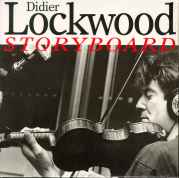
Another name to watch out for on the contemporary scene is the excellent Maciej Afanasjew who, as you might guess, hails from Poland, where he teaches at the Academy of Music in Bydgoszcz and Gdansk. His bebop and fusion playing draws on elements of Didier Lockwood and early Ponty, and also on John Coltrane.
Maciej Afanasjew
Blues Violin
The blues is an important element of any jazz violinist's playing style; even if you're not playing an actual 12-bar blues, you're almost certain to make some use the blues scales (either the major blues scale- a major pentatonic with an extra flattened third), or the minor blues scale (which also has the flattened fifth and flattened seventh) (MORE ABOUT THE BLUES SCALE)
Papa John Creach was probably the best exponent of pure blues violin; he reached wide attention through his work with Jefferson Airplane, but subsequently released several solo albums showing off his style to the full;passionate, soulful playing with simple repeated phrases from the minor blues scale. (MORE ABOUT PAPA JOHN CREACH). A contemporary of Papa John was Don Sugarcane Harris, who worked with Frank Zappa in the early 70's. (MORE ABOUT SUGAR CANE HARRIS)
Perhaps the best British jazz fiddler today is Christian Garrick, who masters the hot club style, the more modern repertoire, and gypsy fiddling. He has developed a fearsome reputation for his work with the gypsy band Szapora, with guitarist John Etheridge, and his own solo projects.
FREE JAZZ
We have Ornette Coleman to thank for “free jazz”-music in which rhythm, harmony, melody and structure are largely abandoned in favour of free expression. He started his career in the early 50’s playing sax in various R&B groups, and soon graduating to bebop. This he found restrictive, and was soon developing his own voice, throwing out all the rules, and making himself very unpopular with other musicians, many of whom would leave the stage when he started to play. His 1960 album “Free Jazz-a collective improvisation” proved both highly divisive and highly influential. Many hated it and everything it stood for, but it opened up new avenues for a whole host of modern free-thinking jazz musicians. In the 1960’s Coleman began playing violin- left handed and self taught. The fact that he had no technique to speak of made little difference within the style of music he was playing. “I think he should stick to his alto sax” was the comment of veteran swing fiddler Stuff Smith.
Among the violinists to follow Coleman’s lead into free jazz are a trio of black American players. Leroy Jenkins (1932-2007) was a classically trained violinist who trod an uncompromising and highly individual path in modern jazz. His music, either free or composed, was harmonically challenging to say the least. He often performed solo, but was best known for his work with the Revolutionary Ensemble. If you’re looking for hummable melodies, foot-tapping rhythms and sweet harmonies, keep looking.
Much rougher in tone and with weaker intonation than Jenkins, nevertheless Billy Bang, who names Jenkins as his chief inspiration, has a much more approachable style. Along with some free and experimental sounds Bang has a strong dose of swing and blues in his playing, and in 1992, with Sun Ra (with whom he worked for 10 years) he recorded a tribute to Stuff Smith. He has over 14 albums under his own name, as well as a number witht the String Trio of New York.
Michael White, based in San Francisco, was another pioneer in free jazz on the violin, and despite having made little impact on the jazz world as a whole, has worked with a number of leading artists including Sun Ra, Pharoah Sanders, Stevie Wonder, McCoy Tyner and John Coltrane. He manages to mix total cacophony with some quite accessible material.
A fierce and uncompromising contemporary British exponent of free jazz violin is Graham Clark. You can hear him on “Improvisations series one” with pianist Stephen Grew- recorded “with no prior preparation and no subsequent manipulation”. He is also well known for his work with the reformed jazz/rock/fusion band Gong
Graham Clark
JAZZ VIOLIN TECHNIQUE
For the fiddle player, jazz has several challenging aspects which set it apart from most folk styles. Each number in a jazz performance starts and ends with a melody which is played more or less "straight" (as written), but the bulk of the number is made up of improvised solos which, whilst following the basic chord sequence, will have little if anything to do with the original tune. This is the opportunity for the soloist to state and develop his own ideas and to inter-react with the rest of the band. Each solo may run several times round the sequence ,and occasionally the band will do "fours", where four bar solos are alternated between musicians. Hopefully the excitement will mount as each soloist tries to copy and elaborate on the other's previous effort. If the audience start leaving, it's clearly time to get back to the "head" and on with the next number!
The jazz violinist needs to be able to play in the higher positions, to be relaxed in almost any key (particularly the flat keys, beloved of wind players), and to play with a rich tone, particularly on slow numbers. Pentatonic and blues scales are invaluable but shouldn't be overused, and a good knowledge of chord structures and sequences is essential, though this can be instinctive rather than conscious.
Most important, and perhaps most elusive of all, the fiddler must be able to swing. This comes mainly from the bowing patterns; notes are typically grouped in dotted pairs but with a subtle and constantly changing emphasis. (MORE ON JAZZ VIOLIN TECHNIQUE)
Among the best-known tunes of the "Hot Club" repertoire are Dinah, Honeysuckle Rose, Sweet Georgia Brown and Undecided. Django and Stephane added many of their own compositions, including Djangology, Minor Swing, Swing '39 and the beautiful ballad Nuages.
Many jazz venues and festivals will occasionally feature a violinist, but one of the best places to hear Hot Club music today is at the annual midsummer festival of Samois-sur-Seine near Paris, where many gypsy musicians gather to celebrate Django and Stephane's remarkable legacy.
CONTEMPORARY GYPSY JAZZ
The music of Django Reinhardt and Stephane Grappelli is usually referred to either as Hot Club or Gypsy Jazz. The gypsy element of the music- the minor keys, furious tempos and chromatic runs came from Reinhardt. Grappelli outlived his partner by many years, and gradually moved away from the style he had used in the 30’s. Gypsy jazz, however, has grown and developed vigorously since Django’s death, among gypsies and non-gypsies alike.
A visit to the Samois festival (held every June in the French town on the Seine where Django lived in his final years), or any other gypsy jazz festival, will quickly show you that the genre is dominated by guitarists, who gather in their hundreds to compare string gauges, plectrum designs and chord substitutions. Yes, they’re an exciting lot. As a fiddle player, you’ll be a rare but highly valued species.
Among the best contemporary gypsy jazz violinists is the Romanian –born Florin Niculescu. He received a full classical training at the George Enescu Academy in Bucharest, before moving to Paris in the early 90’s where he began working with Boulou and Elios Ferre, two of the top gypsy jazz guitarists, with Babik Reinhardt’s “New Quintette du Hot Club de France” and Birelli Legrene’s “Gypsy Project”.
Dorado Schmidt is both a fiddler and guitarist, noted for his fine melodic compositions, and mastery of the gypsy bossa style; his tune Bossa Dorado is now widely played. Also worth discovering are the blind Belgian violinist Tcha Limberger, the German Titi Winterstein, Watti Rosenberg from the famous musical gypsy family from Holland, and from Amsterdam Tim Kliphuis- not a gypsy but a talented and dedicated Grappelli stylist.
Chris Haigh is a jazz violinist based in London; he has played with The Kimbara Brothers, Diz Disley, Le Jazz, The Hot Club of London, Robin Katz and the Quecumbar Allstars. He gives lessons and workshops on jazz violin technique, and has taught jazz violin at Middlesex and Brunel Universities and Truro College. He is the author of several books on fiddle playing, including Exploring Jazz Violin (Schott, 2010)
INTERESTED IN JAZZ VIOLIN LESSONS IN LONDON? CLICK HERE FOR A PAGE ON JAZZ VIOLIN TECHNIQUE AND DETAILS OF TUITION
Links:
Mark Chung's Jazz Strings site
Joe Venuti page on "Red Hot Jazz"site
Joe Venuti (on "All about Jazz" site
Bret Arenson's Stuff Smith biography on Jazz Owl
The Hot Club- source page for all Grappelli's recordings
Christian Garrick
Tim Kliphuis
Hotclub.co.ukThe History of Jazz Music (a guide for children)
London is very lucky to have a venue dedicated to French gypsy jazz , the amazing Quecumbar in Battersea
What Stuff Smith lacks in tone and finesse he more than makes up for with melodic and rhythmic invention, and the sheer force of his playing. This collection gives you an excellent overview of his playing at the peak of his career.
Disk one covers the period 1935-39, and is mostly with his Onyx Club Boys line-up. The majority are vocal numbers, with Smith displaying his “Jive Talkin’” humour that you might be more familiar with from the likes of Louis Jordan. I’s a Muggin is one such number, a big hit for Stuff which was covered by Grappelli and Reinhardt, among others. The solos tend to be short, but some, such as Old Joe’s hittin the Jug, are exceptional; the “outsidedness” of his playing shows him as a player well ahead of his time. The fireworks really start on disk 2, which is mostly instrumental numbers recorded with his trio (with piano and bass) between 1940 and 45. The bebop influence on his playing is clear in numbers such as The Red Jumps, and his playing is full of excitement and danger, peppered throughout with parallel fifths and strident octave licks. We get no less than three versions of Desert Sands, a Smith composition which became something of a theme tune, almost certainly influenced by the Duke Ellington hit Caravan. With 49 tracks, and a 15-page booklet this is terrific value. If you buy nothing else by Stuff Smith, this is the one to get.
Tribute to Stephanie Grappelli

If I had to recommend a single cd of jazz violin of all the ones I’ve ever listened to, this would be it. Lockwood was a protégé of Grappelli in the 1970’s, and absorbed many of the most endearing stylistic traits of the older player. This is heard most clearly on the slow ballads such as Les Valseuses, My one and Only Love. Misty and Tears, where the breathy tone and broken phrasing are pure Grappelli. Lockwood’s rendition of Nuages is the one I always play to students to demonstrate his absolute mastery of harmonics, both natural and artificial, as well as the way in which such incredible depth and expression can be squeezed into 32 bars of melody. Didier Lockwood may once have been a Grappelli disciple, but this album clearly demonstrates that he is his own man, and his playing has moved many steps beyond his former mentor. The faster tracks, such as I Got Rhythm, Pent up House and All the Things you Are, show a strong bebop sensibility, with carefully judged “outside” playing, while Barbizon Blues and The Kid are cool and funky.
The most unique aspect of Lockwood’s playing is his bow control. Every note of a phrase is given the clearest articulation, but between phrases he often takes all the pressure off the bow, and makes little slides, gasps and sighs which make his violin into a living, breathing thing, and a very sexy one at that. I don’t give star ratings for cd’s; even if I did, there wouldn’t be enough in the sky for this one.
Since its publication in 1981, this must have been one of the most popular jazz violin books on the market. Put together by Matt Glaser, former chair of strings at Berklee College, and now director of Roots Music there, it contains faithful transcriptions of 24 Grappelli solos, plus others by Venuti, Ponty, South. Asmussen and Smith. There are also interviews with Grappelli , Ponty and Yehudi Menuhin. There is analysis of each solo and a table of common motifs, and there are comparisons of different solos for the same tune. Glaser makes a good choice of numbers, using classics such as It Don't Mean a Thing, Dinah, Lady be Good, Undecided and Sweet Georgia Brown.
To get the most out of this book you will need a lot of patience to work through the transcriptions, and to get hold of some of the original recordings. Transcription of solos is an essential part of any jazz student's labour, and here Glaser has saved us all a great deal of effort!
Stephane Grappelli: A Biography
This biography of Stephane Grappelli may not be the only one, but it's certainly the most entertaining. Broadcaster Geoffrey Smith, through interviews with Svend Asmussen, Alan Clare, Charles Delaunay, Diz Disley , John Etheridge,, Didier Lockwood, Martin Taylor and others, as well as the Man Himself, has assembled a detailed and engaging portrait of the life of the leading jazz violinist of the 20th Century.
One of the strongest themes of the book is Grappelli's unquenchable work ethic, driven always by the momory of the poverty and insecurity of his youth; "I have always worked...because I must keep away the miseries that happened to me as a child"
The two ends of his career are well know, but perhaps most interesting in Smith's biography is the middle part of Grappelli's life, much of it spent in England, between the dissolution of the partnership with Django, and the revival of his fortunes in the early 1970's. Also fascinating is the insight into Grappelli's attitude to his return to a guitar rhythm section (provided by Diz Disley's trio on the 1973 revival tour), after many years of working wth pianists. Most hot club musicians I know love the chunk-chunk of the Django guitar style, but Grappelli stated 'Oh, that rhythm, I tell you it drive me insane!". He had come to love the sophistication and subtlety of piano chords, and it was largely this that had driven the increasing elegance and advnturousness of his own playing.
This book gave me a deep insight into Grappelli's life and work, and in a writing style so friendly and relaxed that it read like a novel. Highly recommended.
Mel Bay Jazz Fiddle Wizard Book/CD Set
This is one of the most useful jazz tutors I've come across, particularly if you're interested in the more modern end of jazz fiddling. He starts off describing the invaluable bebop scales, where an extra chromatic note in the scale starts each new bar with a chord note on the beat. He talks about chord analysis, inner melodies, and the importance of avoiding starting chord arpeggios on the root. The section I found most useful was a series of II/V/I patterns with altered notes; sharpened and flattened ninths for example, giving a cool, modern, slightly outside sound.
Recorded in 1964, Jazz Long Playing is the hidden treasure at the bottom of Ponty’s vault. It is not widely known that, sandwiched between his brief classical career and his much longer reign as the jazz fusion violin king, Ponty was a bebop player extraordinaire. Only Didier Lockwood has come anywhere near him since. This album, recorded with piano, bass, drums and a little flute has all the evidence you need. Recorded with no effects, and with an almost total absence of vibrato, Ponty achieved a sound equivalent to, and no doubt modelled on, that of Miles Davis circa Kind of Blue. His playing is peppered with unexpected double stops, dissonances and altered notes. On the two blues numbers- YTNOP Blues and Sniffin the Blues the outside notes and chord substitutions are easiest to follow. On the medium tempo numbers such as Une Nuit au Violon and Spanish Castels, his solos move effortlessly from swing 8ths to straight 16th notes, while the up tempo tunes such as Postlude in C or Au Privave, the notes pour out like water from a tap. Perhaps most interesting are the ballads. How would he deal with a romantic gypsy jazz standard such as Django Reinhardt’s Manoir de mes Reves? With no vibrato or gypsy inflection to his playing you would expect it to fall flat, but not a bit of it. Playing a straight bat, and with total confidence, Ponty turns this into a bebop masterpiece. If all you’ve ever heard of jazz violin is swing or jazz fusion, this album is a must.
